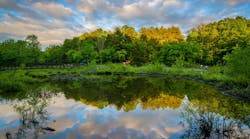Outwitting Muskrats, Geese, and Other Culprits
When my agency started out more than a decade ago with the effort to build a drainage system for southern Staten Island, little did we know that water gardening would become a big part of the job. Southern Staten Island, the surprisingly suburban part of New York City, is the place where freshwater wetlands are making their last stand in the city. My agency, the New York City Department of Environmental Protection, is designing the stormwater drainage network to make use of those streams, ponds, and other wetlands, which we have assembled into a system called the Staten Island Bluebelt. At each point where a hard storm sewer empties into a wetland, a best management practice (BMP) is designed, constructed, and maintained. Those BMPs are places where stormwater velocities are controlled, sediments settle out, stormwater volumes are detained, and pollutants are filtered by wetland plantings. Wetland plantings are crucial to the success of the BMP. Wetland plants are supposed to trap sediment, support colonies of aerobic bacteria that break down pollutants, and contribute to the aesthetic and wildlife habitat values of the constructed wetland. Without the plants, our BMPs become big bathtubs, not wetlands. To get wetland plants to grow, all one has to do is stick them in the ground, right? Wrong! As any backyard gardener knows, it is never that simple, and water gardening on the scale of a BMP presents special challenges. At one site, 4,000 pickerelweed plants were put in the muck of a constructed wetland, and not one survived. The culprit? At least in part, muskrats. In fact, when the pond was drawn down for replanting operations, a row of muskrat burrow holes were revealed just below the water level. The muskrats had quickly set up housekeeping in the BMP with entrances to their living quarters protected from intruders by being located just below the water level. The first planting consisted of dormant rhizomes installed in the fall. These bulbs make tasty treats for muskrats and maybe even for our resident snapping turtles. When the animals pull out the rhizomes to eat them, they take the whole potential plant. We are now trying live plugs in a spring planting; maybe these wetland plants will have a better chance of getting a root system established before an animal comes along and perhaps plucks off only a leaf. Although it limits our ability to have plant diversity, we are also trying plants that muskrats don’t like. Arrow arum and soft rush are two we have in the ground. Muskrats like them about as much as the president’s father likes broccoli. Temporary chicken-wire fences are also part of our effort to protect our newly installed plants. The fences have to extend at least a foot into the ground because muskrats are burrowers. At our larger constructed wetland sites where waterfowl such as Canada geese might land, we’ve stretched string with strips of brightly colored tape attached to it at intervals across the entire wetland. Our wildlife expert tells us that the string discourages birds from landing. The string is another temporary measure we will remove once the plants are established. While it is easy to blame an outside party such as the muskrats, other factors might contribute to the demise of the wetland plants. If stormwater is too quickly introduced into the wetland after the plants are installed, the young plants might not be able to tolerate the increased turbidity. Now, as a general practice, we give the new plants an undisturbed growing season before opening up the wetland to regular full-scale flows. Usually our stormwater wetlands are in place after sanitary sewer systems are installed and all leakages from failing septic systems are eliminated. Unfortunately, in one project we had to build a wetland ahead of the sanitary sewers because a new public school was being built and an adjacent drainage problem had to be corrected immediately. For that wetland, we knew at the outset that sudsy washing-machine water would be an input. Where septic systems are failing, many homeowners divert washing machine water with its pearly sheen directly into the gutters. So for that wetland we chose the old standby–cattails–which actually thrive in nutrient-rich water. In some of our first-generation wetlands, the depth of the permanent pool also might not be right for the plants. Engineers who want maximum volume in the basin for stormwater storage can have a kind of tug-of-war with the wetland specialists who want shallow water for the wetland planting shelves. We have arrived at a standard in which dry-weather depths of our aquatic benches, where wetland plantings are going, can be no more than 18 in. Our failures help us learn and are springboards for success. Despite the loss of many pickerelweed plants at one site, the species is thriving at another. Just this spring, the plants flowered for the first time–delicate blue blossoms rising phoenixlike from the murky muck. Similar to any backyard gardener, we enjoy the springtime successes of our water gardens.

